Journal Description
Biosensors
Biosensors
is an international, peer-reviewed, open access journal on the technology and science of biosensors published monthly online by MDPI.
- Open Access— free for readers, with article processing charges (APC) paid by authors or their institutions.
- High Visibility: indexed within Scopus, SCIE (Web of Science), PubMed, MEDLINE, PMC, Embase, CAPlus / SciFinder, Inspec, and other databases.
- Journal Rank: JCR - Q1 (Instruments and Instrumentation) / CiteScore - Q1 (Instrumentation)
- Rapid Publication: manuscripts are peer-reviewed and a first decision is provided to authors approximately 21.8 days after submission; acceptance to publication is undertaken in 2.8 days (median values for papers published in this journal in the first half of 2025).
- Recognition of Reviewers: reviewers who provide timely, thorough peer-review reports receive vouchers entitling them to a discount on the APC of their next publication in any MDPI journal, in appreciation of the work done.
Impact Factor:
5.6 (2024);
5-Year Impact Factor:
5.7 (2024)
Latest Articles
Dual-Oriented Targeted Nanostructured SERS Label-Free Immunosensor for Detection, Quantification, and Analysis of Breast Cancer Biomarker Concentrations in Blood Serum
Biosensors 2025, 15(7), 447; https://doi.org/10.3390/bios15070447 - 11 Jul 2025
Abstract
In clinical applications of surface-enhanced Raman spectroscopy (SERS) immunosensors, accurately determining analyte biomarker concentrations is essential. This study presents a non-invasive approach for quantifying various breast cancer biomarkers—including human epidermal growth factor receptor II (HER-II) (2+, 3+ (I), 3+ (II), 3+ (III), and
[...] Read more.
In clinical applications of surface-enhanced Raman spectroscopy (SERS) immunosensors, accurately determining analyte biomarker concentrations is essential. This study presents a non-invasive approach for quantifying various breast cancer biomarkers—including human epidermal growth factor receptor II (HER-II) (2+, 3+ (I), 3+ (II), 3+ (III), and positive IV) and CA 15-3—using a directional, plasmonically active, label-free SERS sensor. Each stage of sensor functionalization, conjugation, and biomarker interaction was verified by UV–Vis spectroscopy. Atomic force microscopy (AFM) characterized the morphology of gold nanourchin (GNU)-immobilized printed circuit board (PCB) substrates. An enhancement factor of ≈ 0.5 × 105 was achieved using Rhodamine 6G as the probe molecule. Calibration curves were initially established using standard HER-II solutions at concentrations ranging from 1 to 100 ng/mL and CA 15-3 at concentrations from 10 to 100 U/mL. The SERS signal intensities in the 620–720 nm region were plotted against concentration, yielding linear sensitivity with R2 values of 0.942 and 0.800 for HER-II and CA15-3, respectively. The same procedure was applied to breast cancer serum (BCS) samples, allowing unknown biomarker concentrations to be determined based on the corresponding calibration curves. SERS data were processed using the filtfilt filter from scipy.signal for smoothing and then baseline-corrected with the Improved Asymmetric Least Squares (IASLS) algorithm from the pybaselines.Whittaker library. Principal Component Analysis (PCA) effectively distinguished the sample groups and revealed spectral differences before and after biomarker interactions. Key Raman peaks were attributed to functional groups including N–H (primary and secondary amines), C–H antisymmetric stretching, C–N (amines), C=O antisymmetric stretching, NH3+ (amines), carbohydrates, glycine, alanine, amides III, C=N stretches, and NH2 in primary amides.
Full article
(This article belongs to the Special Issue Miniature Sensors Based on Highly Efficient Chemical and Biological Sensing Interfaces)
Open AccessArticle
FRET-Based TURN-ON Aptasensor for the Sensitive Detection of CK-MB
by
Rabia Asghar, Madiha Rasheed, Xuefei Lv and Yulin Deng
Biosensors 2025, 15(7), 446; https://doi.org/10.3390/bios15070446 - 11 Jul 2025
Abstract
A fluorescent sandwich assay was devised to quantify CK-MB. In a typical immunoassay, antibodies bind to the target, and the detected signal is quantified according to the target’s concentration. We innovated a unique fluorescence assay known as the “enzyme-linked aptamer assay” (ELAA) by
[...] Read more.
A fluorescent sandwich assay was devised to quantify CK-MB. In a typical immunoassay, antibodies bind to the target, and the detected signal is quantified according to the target’s concentration. We innovated a unique fluorescence assay known as the “enzyme-linked aptamer assay” (ELAA) by substituting antibodies with a pair of high-affinity aptamers labelled with biotin, namely apt. A1 and apt. A2. Avidin-labelled ALP binds to biotin-labelled aptamers, hydrolyzing its substrate, 2-phosphoascorbic acid trisodium salt, resulting in the formation of ascorbic acid. The catalytic hydrolysate functions as a reducing agent, causing the deterioration of MoS2 nanosheets. This results in the transformation of MoS2 nanosheets into nanoribbons, leading to the release of quenched AGQDs. The reestablishment of fluorescence is triggered by Förster Resonance Energy Transfer (FRET) between the MoS2 nanoribbons and AGQDs, enhancing the sensitivity of disease biomarker detection. The working range for detection falls between 2.5 nM and 160 nM, and the limit of detection (LOD) for CK-MB is verified at 0.20 nM.
Full article
(This article belongs to the Special Issue Aptamer-Based Biosensors for Point-of-Care Diagnostics)
►▼
Show Figures

Figure 1
Open AccessArticle
Performance of Colorimetric Lateral Flow Immunoassays for Renal Function Evaluation with Human Serum Cystatin C
by
Xushuo Zhang, Sam Fishlock, Peter Sharpe and James McLaughlin
Biosensors 2025, 15(7), 445; https://doi.org/10.3390/bios15070445 - 11 Jul 2025
Abstract
Chronic kidney disease (CKD) is associated with heart failure and neurological disorders. Therefore, point-of-care (POC) detection of CKD is essential, allowing disease monitoring from home and alleviating healthcare professionals’ workload. Lateral flow immunoassays (LFIAs) facilitate POC testing for a renal function biomarker, serum
[...] Read more.
Chronic kidney disease (CKD) is associated with heart failure and neurological disorders. Therefore, point-of-care (POC) detection of CKD is essential, allowing disease monitoring from home and alleviating healthcare professionals’ workload. Lateral flow immunoassays (LFIAs) facilitate POC testing for a renal function biomarker, serum Cystatin C (CysC). LF devices were fabricated and optimised by varying the diluted sample volume, the nitrocellulose (NC) membrane, bed volume, AuNPs’ OD value and volume, and assay formats of partial or full LF systems. Notably, 310 samples were analysed to satisfy the minimum sample size for statistical calculations. This allowed for a comparison between the LFIAs’ results and the general Roche standard assay results from the Southern Health and Social Care Trust. Bland–Altman plots indicated the LFIAs measured 0.51 mg/L lower than the Roche assays. With the 95% confidence interval, the Roche method might be 0.24 mg/L below the LFIAs’ results or 1.27 mg/L above the LFIAs’ results. In summary, the developed non-fluorescent LFIAs could detect clinical CysC values in agreement with Roche assays. Even though the developed LFIA had an increased bias in low CysC concentration (below 2 mg/L) detection, the developed LFIA can still alert patients at the early stages of renal function impairment.
Full article
(This article belongs to the Section Biosensors and Healthcare)
►▼
Show Figures

Figure 1
Open AccessArticle
Carboxymethyl Dextran-Based Biosensor for Simultaneous Determination of IDO-1 and IFN-Gamma in Biological Material
by
Zuzanna Zielinska, Anna Sankiewicz, Natalia Kalinowska, Beata Zelazowska-Rutkowska, Tomasz Guszcz, Leszek Ambroziak, Miroslaw Kondratiuk and Ewa Gorodkiewicz
Biosensors 2025, 15(7), 444; https://doi.org/10.3390/bios15070444 - 10 Jul 2025
Abstract
Indoleamine 2,3-dioxygenase 1 (IDO-1) and interferon-gamma (IFN-γ) are proteins that play a significant role in inflammatory conditions and tumor development. The detection of IDO1 and IFN-γ is crucial for understanding their interplay in immune responses. This study introduced a novel method for the
[...] Read more.
Indoleamine 2,3-dioxygenase 1 (IDO-1) and interferon-gamma (IFN-γ) are proteins that play a significant role in inflammatory conditions and tumor development. The detection of IDO1 and IFN-γ is crucial for understanding their interplay in immune responses. This study introduced a novel method for the simultaneous quantitative determination of IDO-1 and IFN-γ in different biological samples/materials. The method is based on an optical biosensor, with surface plasmon resonance detection carried out by the imaging version of the sensor (SPRi). Biotinylated antibodies immobilized on the surfaces of the linker and carboxymethylated dextran served as the recognition elements for the developed biosensor. Relevant studies were conducted to optimize the activities of the biosensor by employing appropriate reagent concentrations. Validation was performed for each protein separately; low detection and quantification limits were obtained (for IDO-1 LOD = 0.27 ng/mL, LOQ = 0.81 ng/mL; for IFN-γ LOD = 1.76 pg/mL and LOQ = 5.29 pg/mL). The sensor operating ranges were 0.001–10 ng/mL for IDO-1 and 0.1–1000 pg/mL for IFN-γ. The constructed biosensor demonstrated its sensitivity and precision when the appropriate analytical parameters were determined, based on the proposed method. It can also selectively capture IDO-1 and IFN-γ from a large sample matrix. The biosensor efficiency was confirmed by the determination of IDO-1 and IFN-γ in simultaneous measurements of the plasma and urine samples of patients diagnosed with bladder cancer and the control group. The outcomes were compared to those obtained using a certified ELISA test, demonstrating convergence between the two methodologies. The preliminary findings demonstrate the biosensor’s efficacy and suitability for comprehensive analyses of the examined biological samples.
Full article
(This article belongs to the Special Issue Micro/Nanofluidic System-Based Biosensors)
Open AccessReview
Electrochemical Impedance Spectroscopy-Based Biosensors for Label-Free Detection of Pathogens
by
Huaiwei Zhang, Zhuang Sun, Kaiqiang Sun, Quanwang Liu, Wubo Chu, Li Fu, Dan Dai, Zhiqiang Liang and Cheng-Te Lin
Biosensors 2025, 15(7), 443; https://doi.org/10.3390/bios15070443 - 10 Jul 2025
Abstract
The escalating threat of infectious diseases necessitates the development of diagnostic technologies that are not only rapid and sensitive but also deployable at the point of care. Electrochemical impedance spectroscopy (EIS) has emerged as a leading technique for the label-free detection of pathogens,
[...] Read more.
The escalating threat of infectious diseases necessitates the development of diagnostic technologies that are not only rapid and sensitive but also deployable at the point of care. Electrochemical impedance spectroscopy (EIS) has emerged as a leading technique for the label-free detection of pathogens, offering a unique combination of sensitivity, non-invasiveness, and adaptability. This review provides a comprehensive overview of the design and application of EIS-based biosensors tailored for pathogen detection, focusing on critical components such as biorecognition elements, electrode materials, nanomaterial integration, and surface immobilization strategies. Special emphasis is placed on the mechanisms of signal generation under Faradaic and non-Faradaic modes and how these underpin performance characteristics such as the limit of detection, specificity, and response time. The application spectrum spans bacterial, viral, fungal, and parasitic pathogens, with case studies highlighting detection in complex matrices such as blood, saliva, food, and environmental water. Furthermore, integration with microfluidics and point-of-care systems is explored as a pathway toward real-world deployment. Emerging strategies for multiplexed detection and the utilization of novel nanomaterials underscore the dynamic evolution of the field. Key challenges—including non-specific binding, matrix effects, the inherently low ΔRct/decade sensitivity of impedance transduction, and long-term stability—are critically evaluated alongside recent breakthroughs. This synthesis aims to support the future development of robust, scalable, and user-friendly EIS-based pathogen biosensors with the potential to transform diagnostics across healthcare, food safety, and environmental monitoring.
Full article
(This article belongs to the Special Issue Material-Based Biosensors and Biosensing Strategies)
Open AccessArticle
Utilizing Circadian Heart Rate Variability Features and Machine Learning for Estimating Left Ventricular Ejection Fraction Levels in Hypertensive Patients: A Composite Multiscale Entropy Analysis
by
Nanxiang Zhang, Qi Pan, Shuo Yang, Leen Huang, Jianan Yin, Hai Lin, Xiang Huang, Chonglong Ding, Xinyan Zou, Yongjun Zheng and Jinxin Zhang
Biosensors 2025, 15(7), 442; https://doi.org/10.3390/bios15070442 - 10 Jul 2025
Abstract
Background: Early identification of left ventricular ejection fraction (LVEF) levels during the progression of hypertension is essential to prevent cardiac deterioration. However, achieving a non-invasive, cost-effective, and definitive assessment is challenging. It has prompted us to develop a comprehensive machine learning framework for
[...] Read more.
Background: Early identification of left ventricular ejection fraction (LVEF) levels during the progression of hypertension is essential to prevent cardiac deterioration. However, achieving a non-invasive, cost-effective, and definitive assessment is challenging. It has prompted us to develop a comprehensive machine learning framework for the automatic quantitative estimation of LVEF levels from electrocardiography (ECG) signals. Methods: We enrolled 200 hypertensive patients from Zhongshan City, Guangdong Province, China, from 1 November 2022 to 1 January 2025. Participants underwent 24 h Holter monitoring and echocardiography for LVEF estimation. We developed a comprehensive machine learning framework that initiated with preprocessed ECG signal in one-hour intervals to extract CMSE-based heart rate variability (HRV) features, then utilized machine learning models such as linear regression (LR), Support Vector Machines (SVMs), and random forests (RFs) with recursive feature elimination for optimal LVEF estimation. Results: The LR model, notably during early night interval (20:00–21:00), achieved a RMSE of 4.61% and a MAE of 3.74%, highlighting its superiority. Compared with other similar studies, key CMSE parameters (Scales 1, 5, Slope 1–5, and Area 1–5) can effectively enhance regression models’ estimation performance. Conclusion: Our findings suggest that CMSE-derived circadian HRV features from Holter ECG could serve as a non-invasive, cost-effective, and interpretable solution for LVEF assessment in community settings. From a machine learning interpretable perspective, the proposed method emphasized CMSE’s clinical potential in capturing autonomic dynamics and cardiac function fluctuations.
Full article
(This article belongs to the Special Issue Latest Wearable Biosensors—2nd Edition)
►▼
Show Figures
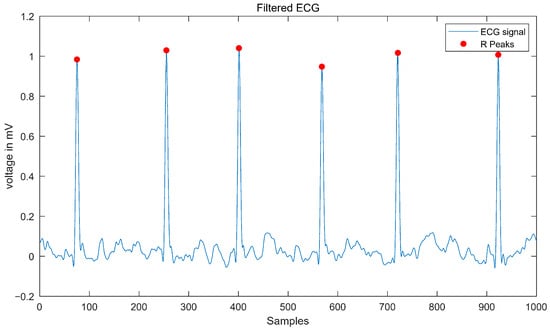
Figure 1
Open AccessArticle
Non-Monotonic Effect of Substrate Inhibition in Conjunction with Diffusion Limitation on the Response of Amperometric Biosensors
by
Romas Baronas
Biosensors 2025, 15(7), 441; https://doi.org/10.3390/bios15070441 - 9 Jul 2025
Abstract
The non-monotonic behavior of amperometric enzyme-based biosensors under uncompetitive and noncompetitive (mixed) substrate inhibition is investigated computationally using a two-compartment model consisting of an enzyme layer and an outer diffusion layer. The model is based on a system of reaction–diffusion equations that includes
[...] Read more.
The non-monotonic behavior of amperometric enzyme-based biosensors under uncompetitive and noncompetitive (mixed) substrate inhibition is investigated computationally using a two-compartment model consisting of an enzyme layer and an outer diffusion layer. The model is based on a system of reaction–diffusion equations that includes a nonlinear term associated with non-Michaelis–Menten kinetics of the enzymatic reaction and accounts for the partitioning between layers. In addition to the known effect of substrate inhibition, where the maximum biosensor current differs from the steady-state output, it has been determined that external diffusion limitations can also cause the appearance of a local minimum in the current. At substrate concentrations greater than both the Michaelis–Menten constant and the uncompetitive substrate inhibition constant, and in the presence of external diffusion limitation, the transient response of the biosensor, after immersion in the substrate solution, may follow a five-phase pattern depending on the model parameter values: it starts from zero, reaches a global or local maximum, decreases to a local minimum, increases again, and finally decreases to a steady intermediate value. The biosensor performance is analyzed numerically using the finite difference method.
Full article
(This article belongs to the Special Issue Novel Designs and Applications for Electrochemical Biosensors)
►▼
Show Figures
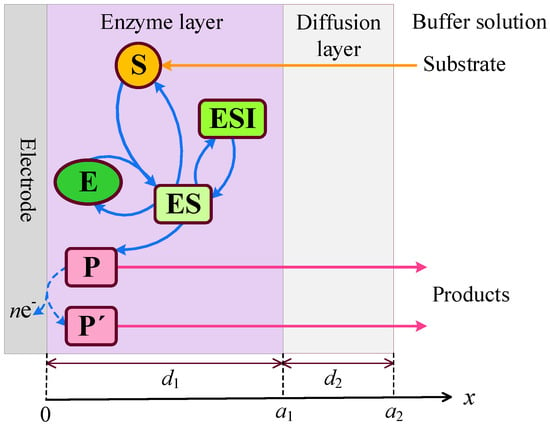
Figure 1
Open AccessReview
Polymeric Composite-Based Electrochemical Sensing Devices Applied in the Analysis of Monoamine Neurotransmitters
by
Stelian Lupu
Biosensors 2025, 15(7), 440; https://doi.org/10.3390/bios15070440 - 9 Jul 2025
Abstract
Electroanalysis of monoamine neurotransmitters is a useful tool for monitoring relevant neurodegenerative disorders and diseases. Electroanalysis of neurotransmitters using analytical devices consisting of electrodes modified with tailored and nanostructured composite materials is an active research topic nowadays. Nano- and microstructured composite materials composed
[...] Read more.
Electroanalysis of monoamine neurotransmitters is a useful tool for monitoring relevant neurodegenerative disorders and diseases. Electroanalysis of neurotransmitters using analytical devices consisting of electrodes modified with tailored and nanostructured composite materials is an active research topic nowadays. Nano- and microstructured composite materials composed of various organic conductive polymers, metal/metal oxide nanoparticles, and carbonaceous materials enable an increase in the performance of electroanalytical sensing devices. Synergistic properties resulting from the combination of various pristine nanomaterials have enabled faster kinetics and increased overall performance. Herein, recent results related to the design and elaboration of electroanalytical sensing devices based on cost-effective and reliable nano- and microstructured composite materials for the quantification of monoamine neurotransmitters are presented. The discussion focuses on the fabrication procedures and detection strategies, highlighting the capabilities of the analytical platforms used in the determination of relevant analytes. The review aims to present the main benefits of using composite nanostructured materials in the electroanalysis of monoamine neurotransmitters.
Full article
(This article belongs to the Special Issue Innovative Biosensing Technologies for Sustainable Healthcare)
►▼
Show Figures
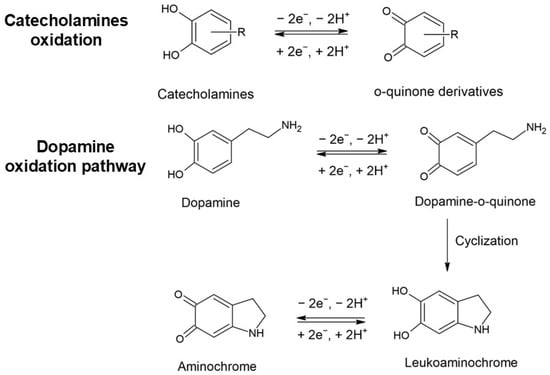
Figure 1
Open AccessArticle
Assessment of Microvascular Disturbances in Children with Type 1 Diabetes—A Pilot Study
by
Anna Wołoszyn-Durkiewicz, Edyta Dąbrowska, Marcin Hellmann, Anna Jankowska, Mariusz J. Kujawa, Dominik Świętoń, Agata Durawa, Joanna Kuhn, Joanna Szypułowska-Grzyś, Agnieszka Brandt-Varma, Jacek Burzyński, Jędrzej Chrzanowski, Arkadiusz Michalak, Aleksandra Michnowska, Dalia Trzonek, Jacek Wolf, Krzysztof Narkiewicz, Edyta Szurowska and Małgorzata Myśliwiec
Biosensors 2025, 15(7), 439; https://doi.org/10.3390/bios15070439 - 8 Jul 2025
Abstract
Endothelial dysfunction appears early in type 1 diabetes (T1D). The detection of the first vascular disturbances in T1D patients is crucial, and the introduction of novel techniques, such as flow-mediated skin fluorescence (FMSF) and adaptive optics retinal camera (Rtx) imaging, gives hope for
[...] Read more.
Endothelial dysfunction appears early in type 1 diabetes (T1D). The detection of the first vascular disturbances in T1D patients is crucial, and the introduction of novel techniques, such as flow-mediated skin fluorescence (FMSF) and adaptive optics retinal camera (Rtx) imaging, gives hope for better detection and prevention of angiopathies in the future. In this study, we aimed to investigate microcirculation disturbances in pediatric patients with T1D with the use of FMSF and Rtx imaging. This research focused especially on the relationship between microvascular parameters obtained in FMSF and Rtx measurements, and the glycemic control evaluated in continuous glucose monitoring (CGM) reports. We observed significantly increased wall thickness (WT) and wall-to-lumen ratio (WLR) values in T1D patients in comparison to the control group. Although we did not observe significant differences between the T1D and control groups in the FMSF results, a trend toward significance between the time in range (TIR) and hyperemic response (HRmax) and an interesting correlation between the carotid intima-media thickness (cIMTmax) and HRmax. were observed. In conclusion, FMSF and Rtx measurments are innovative techniques enabling the detection of early microvascular disturbances.
Full article
(This article belongs to the Section Biosensors and Healthcare)
►▼
Show Figures
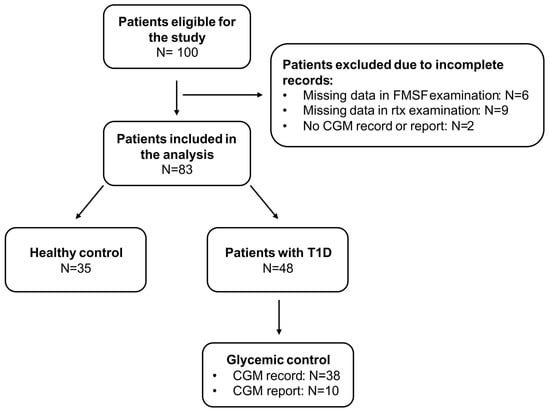
Figure 1
Open AccessReview
Heavy Metal Ion Detection Based on Lateral Flow Assay Technology: Principles and Applications
by
Xiaobo Xie, Xinyue Hu, Xin Cao, Qianhui Zhou, Wei Yang, Ranran Yu, Shuaiqi Liu, Huili Hu, Ji Qi and Zhiyang Zhang
Biosensors 2025, 15(7), 438; https://doi.org/10.3390/bios15070438 - 7 Jul 2025
Abstract
Heavy metal ions pose a significant threat to the environment and human health due to their high toxicity and bioaccumulation. Traditional instrumentations, although sensitive, are often complex, costly, and unsuitable for on-site rapid detection of heavy metal ions. Lateral flow assay technology has
[...] Read more.
Heavy metal ions pose a significant threat to the environment and human health due to their high toxicity and bioaccumulation. Traditional instrumentations, although sensitive, are often complex, costly, and unsuitable for on-site rapid detection of heavy metal ions. Lateral flow assay technology has emerged as a research hotspot due to its rapid, simple, and cost-effective advantages. This review summarizes the applications of lateral flow assay technology based on nucleic acid molecules and antigen–antibody interactions in heavy metal ion detection, focusing on recognition mechanisms such as DNA probes, nucleic acid enzymes, aptamers, and antigen–antibody binding, as well as signal amplification strategies on lateral flow testing strips. By incorporating these advanced technologies, the sensitivity and specificity of lateral flow assays have been significantly improved, enabling highly sensitive detection of various heavy metal ions, including Hg2+, Cd2+, Pb2+, and Cr3+. In the future, the development of lateral flow assay technology for detection of heavy metal ions will focus on multiplex detection, optimization of signal amplification strategies, integration with portable devices, and standardization and commercialization. With continuous technological advancements, lateral flow assay technology will play an increasingly important role in environmental monitoring, food safety, and public health.
Full article
(This article belongs to the Special Issue Miniature Sensors Based on Highly Efficient Chemical and Biological Sensing Interfaces)
►▼
Show Figures
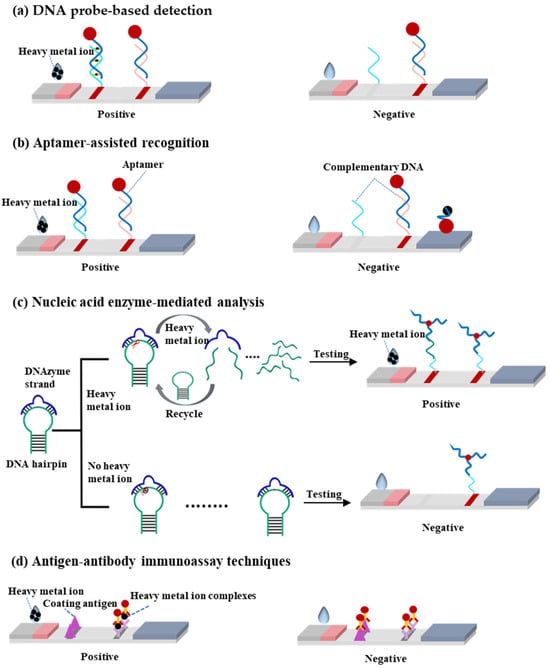
Figure 1
Open AccessReview
Recent Advances in Metal–Organic Framework-Based Nanozymes for Intelligent Microbial Biosensing: A Comprehensive Review of Biomedical and Environmental Applications
by
Alemayehu Kidanemariam and Sungbo Cho
Biosensors 2025, 15(7), 437; https://doi.org/10.3390/bios15070437 - 7 Jul 2025
Abstract
Metal–organic framework (MOF)-based nanozymes represent a groundbreaking frontier in advanced microbial biosensing, offering unparalleled catalytic precision and structural tunability to mimic natural enzymes with superior stability and specificity. By engineering the structural features and forming composites, MOFs are precisely tailored to amplify nanozymatic
[...] Read more.
Metal–organic framework (MOF)-based nanozymes represent a groundbreaking frontier in advanced microbial biosensing, offering unparalleled catalytic precision and structural tunability to mimic natural enzymes with superior stability and specificity. By engineering the structural features and forming composites, MOFs are precisely tailored to amplify nanozymatic activity, enabling the highly sensitive, rapid, and cost-effective detection of a broad spectrum of microbial pathogens critical to biomedical diagnostics and environmental monitoring. These advanced biosensors surpass traditional enzyme systems in robustness and reusability, integrating seamlessly with smart diagnostic platforms for real-time, on-site microbial identification. This review highlights cutting-edge developments in MOF nanozyme design, composite engineering, and signal transduction integration while addressing pivotal challenges such as biocompatibility, complex matrix interference, and scalable manufacturing. Looking ahead, the convergence of multifunctional MOF nanozymes with portable technologies and optimized in vivo performance will drive transformative breakthroughs in early disease detection, antimicrobial resistance surveillance, and environmental pathogen control, establishing a new paradigm in next-generation smart biosensing.
Full article
(This article belongs to the Special Issue Microbial Biosensor: From Design to Applications—2nd Edition)
►▼
Show Figures

Graphical abstract
Open AccessReview
Democratization of Point-of-Care Viral Biosensors: Bridging the Gap from Academia to the Clinic
by
Westley Van Zant and Partha Ray
Biosensors 2025, 15(7), 436; https://doi.org/10.3390/bios15070436 - 7 Jul 2025
Abstract
The COVID-19 pandemic and recent viral outbreaks have highlighted the need for viral diagnostics that balance accuracy with accessibility. While traditional laboratory methods remain essential, point-of-care solutions are critical for decentralized testing at the population level. However, a gap persists between academic proof-of-concept
[...] Read more.
The COVID-19 pandemic and recent viral outbreaks have highlighted the need for viral diagnostics that balance accuracy with accessibility. While traditional laboratory methods remain essential, point-of-care solutions are critical for decentralized testing at the population level. However, a gap persists between academic proof-of-concept studies and clinically viable tools, with novel technologies remaining inaccessible to clinics due to cost, complexity, training, and logistical constraints. Recent advances in surface functionalization, assay simplification, multiplexing, and performance in complex media have improved the feasibility of both optical and non-optical sensing techniques. These innovations, coupled with scalable manufacturing methods such as 3D printing and streamlined hardware production, pave the way for practical deployment in real-world settings. Additionally, software-assisted data interpretation, through simplified readouts, smartphone integration, and machine learning, enables the broader use of diagnostics once limited to experts. This review explores improvements in viral diagnostic approaches, including colorimetric, optical, and electrochemical assays, showcasing their potential for democratization efforts targeting the clinic. We also examine trends such as open-source hardware, modular assay design, and standardized reporting, which collectively reduce barriers to clinical adoption and the public dissemination of information. By analyzing these interdisciplinary advances, we demonstrate how emerging technologies can mature into accessible, low-cost diagnostic tools for widespread testing.
Full article
(This article belongs to the Special Issue Biosensors for Monitoring and Diagnostics)
►▼
Show Figures

Figure 1
Open AccessReview
Peroxidase-Mimicking Nanozymes of Nitrogen Heteroatom-Containing Graphene Oxide for Biomedical Applications
by
Phan Gia Le, Daesoo Kim, Jae-Pil Chung and Sungbo Cho
Biosensors 2025, 15(7), 435; https://doi.org/10.3390/bios15070435 - 7 Jul 2025
Abstract
Nanozymes constitute a rapidly advancing frontier in scientific research, attracting widespread international interest, particularly for their role in facilitating cascade reactions. Despite their initial discovery a few years ago, significant hurdles persist in optimizing their catalytic performance and substrate specificity—challenges that are especially
[...] Read more.
Nanozymes constitute a rapidly advancing frontier in scientific research, attracting widespread international interest, particularly for their role in facilitating cascade reactions. Despite their initial discovery a few years ago, significant hurdles persist in optimizing their catalytic performance and substrate specificity—challenges that are especially critical in the context of biomedical diagnostics. Within this domain, nitrogen-containing graphene oxide-based nanozymes exhibiting peroxidase-mimicking activity have emerged as particularly promising candidates, owing to the exceptional electrical conductivity, mechanical flexibility, and structural resilience of reduced graphene oxide-based materials. Intensive efforts have been devoted to engineering graphene oxide structures to enhance their peroxidase-like functionality. Nonetheless, the practical implementation of such nanozymes remains under active investigation and demands further refinement. This review synthesizes the current developments in nitrogen heteroatom-containing graphene oxide nanozymes and their derivative nanozymes, emphasizing recent breakthroughs and biomedical applications. It concludes by exploring prospective directions and the broader potential of these materials in the biomedical landscape.
Full article
(This article belongs to the Special Issue Cutting-Edge Nanozyme Biosensing Strategies for Biomedical and Environmental Applications)
►▼
Show Figures
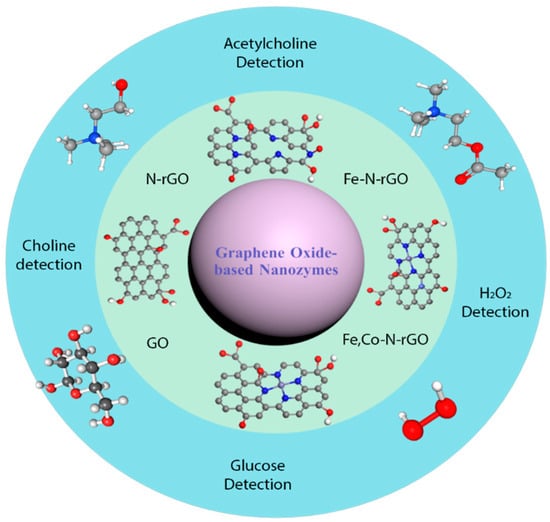
Figure 1
Open AccessReview
Enhancing ELISA Sensitivity: From Surface Engineering to Synthetic Biology
by
Hye-Bin Jeon, Dong-Yeon Song, Yu Jin Park and Dong-Myung Kim
Biosensors 2025, 15(7), 434; https://doi.org/10.3390/bios15070434 - 6 Jul 2025
Abstract
Accurate and sensitive detection of protein biomarkers is critical for advancing in vitro diagnostics (IVD), yet conventional enzyme-linked immunosorbent assays (ELISA) often fall short in terms of sensitivity compared to nucleic acid-based tests. Bridging this sensitivity gap is essential for improving diagnostic accuracy,
[...] Read more.
Accurate and sensitive detection of protein biomarkers is critical for advancing in vitro diagnostics (IVD), yet conventional enzyme-linked immunosorbent assays (ELISA) often fall short in terms of sensitivity compared to nucleic acid-based tests. Bridging this sensitivity gap is essential for improving diagnostic accuracy, particularly in diseases where protein levels better reflect disease progression than nucleic acid biomarkers. In this review, we present strategies developed to enhance the sensitivity of ELISA, structured according to the sequential steps of the assay workflow. Beginning with surface modifications, we then discuss the methodologies to improve mixing and washing efficiency, followed by a summary of recent advances in signal generation and amplification techniques. In particular, we highlight the emerging role of cell-free synthetic biology in augmenting ELISA sensitivity. Recent developments such as expression immunoassays, CRISPR-linked immunoassays (CLISA), and T7 RNA polymerase–linked immunosensing assays (TLISA) demonstrate how programmable nucleic acid and protein synthesis systems can be integrated into ELISA workflows to surpass the present sensitivity, affordability, and accessibility. By combining synthetic biology-driven amplification and signal generation mechanisms with traditional immunoassay formats, ELISA is poised to evolve into a highly modular and adaptable diagnostic platform, representing a significant step toward the next generation of highly sensitive and programmable immunoassays.
Full article
(This article belongs to the Special Issue Nano Biosensors and Their Applications for In Vivo/Vitro Diagnosis—3rd Edition)
►▼
Show Figures

Figure 1
Open AccessArticle
A Signal On-Off Ratiometric Molecularly Imprinted Electrochemical Sensor Based on MXene/PEI-MWCNTs Signal Amplification for the Detection of Diuron
by
Yi He, Jin Zhu, Libo Li, Tianyan You and Xuegeng Chen
Biosensors 2025, 15(7), 433; https://doi.org/10.3390/bios15070433 - 5 Jul 2025
Abstract
Diuron (DU) is a widely used phenylurea herbicide designed to inhibit weed growth, but its high toxicity and prolonged half-life contribute significantly to environmental contamination. The majority of electrochemical (EC) sensors typically rely on a single response signal for the detection of DU,
[...] Read more.
Diuron (DU) is a widely used phenylurea herbicide designed to inhibit weed growth, but its high toxicity and prolonged half-life contribute significantly to environmental contamination. The majority of electrochemical (EC) sensors typically rely on a single response signal for the detection of DU, rendering them highly susceptible to interference from variable background noise in complex environments, thereby reducing the selectivity and robustness. By integrating molecularly imprinted polymer (MIP) with a ratiometric strategy, the aforementioned issues could be solved. In this study, a novel signal on-off ratiometric MIP-EC sensor was developed based on the MXene/PEI-MWCNTs nanocomposite for the detection of DU. Positively charged PEI-MWCNTs was used as an interlayer spacer and embedded into negatively charged MXene by a simple electrostatic self-assembly method. This effectively prevented the agglomeration of MXene and enhanced its electrocatalytic performance. The MIP was synthesized via electropolymerization with DU serving as the template molecule and the selectivity was enhanced by leveraging the gate effect of MIP. Subsequently, a ratiometric MIP-EC sensor was designed by introducing [Fe(CN)6]3−/4− into the electrolyte solution as an internal reference. Additionally, the current ratio signal (IDU/I[Fe(CN)6]3−/4−) and DU concentration exhibited a good linear relationship within the range of 0.1 to 100 µM, with a limit of detection (LOD) of 30 nM (S/N = 3). In comparison with conventional single-signal MIP-EC sensing, the developed ratiometric MIP-EC sensing demonstrates superior reproducibility and accuracy. At the same time, the proposed sensor was successfully applied to the quantitative analysis of DU residues in soil samples, yielding highly satisfactory results.
Full article
(This article belongs to the Special Issue Advances in Biosensors Based on Framework Materials)
►▼
Show Figures

Figure 1
Open AccessArticle
Development of a Colloidal Gold-Based Immunochromatographic Strip Targeting the Nucleoprotein for Rapid Detection of Canine Distemper Virus
by
Zichen Zhang, Zhuangli Bi, Qingqing Du, Miao Zhang, Linying Cai, Yiming Fan, Jingjie Tang, Mingxing Hu, Shiqiang Zhu, Aoxing Tang, Guijun Wang, Guangqing Liu and Yingqi Zhu
Biosensors 2025, 15(7), 432; https://doi.org/10.3390/bios15070432 - 4 Jul 2025
Abstract
Canine distemper, a fatal and highly transmissible disease caused by the canine distemper virus (CDV), poses a major threat to the companion animal industry. An urgent need exists for a rapid, specific, and simple method for the detection of this disease in order
[...] Read more.
Canine distemper, a fatal and highly transmissible disease caused by the canine distemper virus (CDV), poses a major threat to the companion animal industry. An urgent need exists for a rapid, specific, and simple method for the detection of this disease in order to improve its prevention and control. In this research, two monoclonal antibodies (mAbs), 1D3E9 and 1H9B7, were prepared, both of which specifically recognize the nucleoprotein (N protein) of CDV, and an immunochromatographic assay for CDV detection was subsequently developed using these mAbs. The results showed that both mAbs belong to the IgG1 subclass with kappa light chains. 1D3E9 was found to recognize the linear epitope 410AGPKQSQITFLH421, while 1H9B7 targeted the epitope 450HFNDERFPGH459. The test strips exhibited high specificity and good stability for up to two months when stored at 4, 25, and 37 °C. The assay exhibited a sensitivity of 102.39 TCID50/0.1 mL. When compared with RT-PCR for detecting CDV in clinical samples, the concordance rate was 91.67%. Thus, this method shows great potential for facilitating rapid on-site detection of CDV and could be highly beneficial from the viewpoint of disease surveillance and control.
Full article
(This article belongs to the Section Biosensors and Healthcare)
►▼
Show Figures

Figure 1
Open AccessArticle
A New Sensing Platform Based in CNF-TiO2NPs-Wax on Polyimide Substrate for Celiac Disease Diagnostic
by
Evelyn Marín-Barroso, Maria A. Ferroni-Martini, Eduardo A. Takara, Matias Regiart, Martín A. Fernández-Baldo, Germán A. Messina, Franco A. Bertolino and Sirley V. Pereira
Biosensors 2025, 15(7), 431; https://doi.org/10.3390/bios15070431 - 4 Jul 2025
Abstract
Celiac disease (CD), a human leukocyte antigen-associated disorder, is caused by gluten sensitivity and is characterized by mucosal alterations in the small intestine. Currently, its diagnosis involves the determination of serological markers. The traditional method for clinically determining these markers is the enzyme-linked
[...] Read more.
Celiac disease (CD), a human leukocyte antigen-associated disorder, is caused by gluten sensitivity and is characterized by mucosal alterations in the small intestine. Currently, its diagnosis involves the determination of serological markers. The traditional method for clinically determining these markers is the enzyme-linked immunosorbent assay. However, immunosensors offer sensitivity and facilitate the development of miniaturized and portable analytical systems. This work focuses on developing an amperometric immunosensor for the quantification of IgA antibodies against tissue transglutaminase (IgA anti-TGA) in human serum samples, providing information on a critical biomarker for CD diagnosis. The electrochemical device was designed on a polyimide substrate using a novel solid ink of wax and carbon nanofibers (CNFs). The working electrode microzone was defined by incorporating aminofunctionalized TiO2 nanoparticles (TiO2NPs). The interactions and morphology of CNFs/wax and TiO2NPs/CNFs/wax electrodes were assessed through different characterization techniques. Furthermore, the device was electrochemically characterized, demonstrating that the incorporation of CNFs into the wax matrix significantly enhanced its conductivity and increased the active surface area of the electrode, while TiO2NPs contributed to the immunoreaction area. The developed device exhibited remarkable sensitivity, selectivity, and reproducibility. These results indicate that the fabricated device is a robust and reliable tool for the precise serological diagnosis of CD.
Full article
(This article belongs to the Special Issue Advanced Electrochemical Biosensors and Their Applications)
►▼
Show Figures

Figure 1
Open AccessReview
Protein, Nucleic Acid, and Nanomaterial Engineering for Biosensors and Monitoring
by
Milica Crnoglavac Popović, Vesna Stanković, Dalibor Stanković and Radivoje Prodanović
Biosensors 2025, 15(7), 430; https://doi.org/10.3390/bios15070430 - 3 Jul 2025
Abstract
The engineering of proteins, nucleic acids, and nanomaterials has significantly advanced the development of biosensors for the monitoring of rare diseases. These innovative biosensing technologies facilitate the early detection and management of conditions that often lack adequate diagnostic solutions. By utilizing engineered proteins
[...] Read more.
The engineering of proteins, nucleic acids, and nanomaterials has significantly advanced the development of biosensors for the monitoring of rare diseases. These innovative biosensing technologies facilitate the early detection and management of conditions that often lack adequate diagnostic solutions. By utilizing engineered proteins and functional nucleic acids, such as aptamers and nucleic acid sensors, these biosensors can achieve high specificity in identifying the biomarkers associated with rare diseases. The incorporation of nanomaterials, like nanoparticles and nanosensors, enhances sensitivity and allows for the real-time monitoring of biochemical changes, which is critical for timely intervention. Moreover, integrating these technologies into wearable devices provides patients and healthcare providers with continuous monitoring capabilities, transforming the landscape of healthcare for rare diseases. The ability to detect low-abundance biomarkers in varied sample types, such as blood or saliva, can lead to breakthroughs in understanding disease pathways and personalizing treatment strategies. As the field continues to evolve, the combination of protein, nucleic acid, and nanomaterial engineering will play a crucial role in developing next-generation biosensors that are not only cost-effective but also easy to use, ultimately improving outcomes and the quality of life for individuals affected by rare diseases.
Full article
(This article belongs to the Special Issue Biosensors for Monitoring and Diagnostics)
►▼
Show Figures
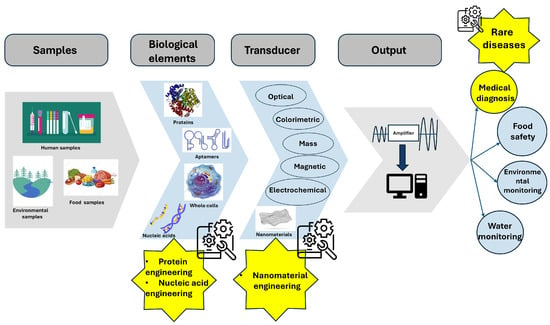
Figure 1
Open AccessArticle
A Microsphere-Based Sensor for Point-of-Care and Non-Invasive Acetone Detection
by
Oscar Osorio Perez, Ngan Anh Nguyen, Landon Denham, Asher Hendricks, Rodrigo E. Dominguez, Eun Ju Jeong, Marcio S. Carvalho, Mateus Lima, Jarrett Eshima, Nanxi Yu, Barbara Smith, Shaopeng Wang, Doina Kulick and Erica Forzani
Biosensors 2025, 15(7), 429; https://doi.org/10.3390/bios15070429 - 3 Jul 2025
Abstract
Ketones, which are key biomarkers of fat oxidation, are relevant for metabolic health maintenance and disease development, making continuous monitoring essential. In this study, we introduce a novel colorimetric sensor designed for potential continuous acetone detection in biological fluids. The sensor features a
[...] Read more.
Ketones, which are key biomarkers of fat oxidation, are relevant for metabolic health maintenance and disease development, making continuous monitoring essential. In this study, we introduce a novel colorimetric sensor designed for potential continuous acetone detection in biological fluids. The sensor features a polydimethylsiloxane (PDMS) shell that encapsulates a sensitive and specific liquid-core acetone-sensing probe. The microsphere sensors were characterized by evaluating their size, PDMS shell thickness, colorimetric response, and sensitivity under realistic conditions, including 100% relative humidity (RH) and CO2 interference. The microsphere size and sensor sensitivity can be controlled by modifying the fabrication parameters. Critically, the sensor showed high selectivity for acetone detection, with negligible interference from CO2 concentrations up to 4%. In addition, the sensor displayed good reproducibility (CV < 5%) and stability under realistic storage conditions (over two weeks at 4 °C). Finally, the accuracy of the microsphere sensor was validated against a gold standard gas chromatography-mass spectrometry (GC-MS) method using simulated and real breath samples from healthy individuals and type 1 diabetes patients. The correlation between the microsphere sensor and GC-MS produced a linear fit with a slope of 0.948 and an adjusted R-squared value of 0.954. Therefore, the liquid-core microsphere-based sensor is a promising platform for acetone body fluid analysis.
Full article
(This article belongs to the Special Issue Applications of Biosensors in Medicine, the Food Industry, and Disease Diagnosis)
►▼
Show Figures

Figure 1
Open AccessArticle
Immunosensor Enhanced with Silver Nanocrystals for On-Chip Prostate-Specific Antigen Detection
by
Timothy A. Okhai, Kefilwe V. Mokwebo, Marlon Oranzie, Usisipho Feleni and Lukas W. Snyman
Biosensors 2025, 15(7), 428; https://doi.org/10.3390/bios15070428 - 3 Jul 2025
Abstract
An electrochemical immunosensor for the quantification of prostate-specific antigens (PSAs) using silver nanocrystals (AgNCs) is reported. The silver nanocrystals were synthesized using a conventional citrate reduction protocol. The silver nanocrystals were characterized using scanning electron microscopy (SEM) and field effect scanning electron microscopy
[...] Read more.
An electrochemical immunosensor for the quantification of prostate-specific antigens (PSAs) using silver nanocrystals (AgNCs) is reported. The silver nanocrystals were synthesized using a conventional citrate reduction protocol. The silver nanocrystals were characterized using scanning electron microscopy (SEM) and field effect scanning electron microscopy (FESEM), X-ray diffraction (XRD), high-resolution transmission electron microscopy (HRTEM), Fourier-transform infrared spectroscopy (FTIR), UV-Vis spectroscopy, and small-angle X-ray scattering (SAXS). The proposed immunosensor was fabricated on a glassy carbon electrode (GCE), sequentially, by drop-coating AgNCs, the electro-deposition of EDC-NHS, the immobilization of anti-PSA antibody (Ab), and dropping of bovine serum albumin (BSA) to prevent non-specific binding sites. Each stage of the fabrication process was characterized by cyclic voltammetry (CV). Using square wave voltammetry (SWV), the proposed immunosensor displayed high sensitivity in detecting PSA over a concentration range of 1 to 10 ng/mL with a detection limit of 1.14 ng/mL and R2 of 0.99%. The immunosensor was selective in the presence of interfering substances like glucose, urea, L-cysteine, and alpha-methylacyl-CoA racemase (AMACR) and it showed good stability and repeatability. These results compare favourably with some previously reported results on similar or related technologies for PSA detection.
Full article
(This article belongs to the Special Issue Photonics for Bioapplications: Sensors and Technology—2nd Edition)
►▼
Show Figures

Figure 1

Journal Menu
► ▼ Journal Menu-
- Biosensors Home
- Aims & Scope
- Editorial Board
- Reviewer Board
- Topical Advisory Panel
- Instructions for Authors
- Special Issues
- Topics
- Sections & Collections
- Article Processing Charge
- Indexing & Archiving
- Editor’s Choice Articles
- Most Cited & Viewed
- Journal Statistics
- Journal History
- Journal Awards
- Conferences
- Editorial Office
Journal Browser
► ▼ Journal BrowserHighly Accessed Articles
Latest Books
E-Mail Alert
News
Topics
Topic in
Analytica, Molecules, Nanomaterials, Polymers, Magnetochemistry, Biosensors
Nanomaterials in Green Analytical Chemistry
Topic Editors: George Zachariadis, Rosa Peñalver, Natalia ManousiDeadline: 15 August 2025
Topic in
Applied Sciences, Biosensors, Chips, Micromachines, Molecules
Advances in Microfluidics and Lab on a Chip Technology, 2nd Edition
Topic Editors: Roman Grzegorz Szafran, Yi YangDeadline: 31 August 2025
Topic in
Applied Sciences, Biosensors, Designs, Electronics, Materials, Micromachines, Applied Biosciences
Wearable Bioelectronics: The Next Generation of Health Insights
Topic Editors: Shuo Gao, Yu Wu, Wenyu WangDeadline: 31 March 2026
Topic in
Applied Nano, Biosensors, Materials, Nanomaterials, Chemosensors, Applied Biosciences, Laboratories
Applications of Nanomaterials in Biosensing: Current Trends and Future Prospects
Topic Editors: Kundan Sivashanmugan, Xianming KongDeadline: 30 April 2026

Conferences
Special Issues
Special Issue in
Biosensors
Advanced Bioelectronics for Healthcare Monitoring and Disease Diagnosis
Guest Editors: Xingcan Huang, Jiyu Li, Kuanming Yao, Sancan HanDeadline: 15 July 2025
Special Issue in
Biosensors
Functionalized Probes for Bioimaging and Biosensing
Guest Editor: Yalin QiDeadline: 15 July 2025
Special Issue in
Biosensors
CRISPR/Cas-Based Biosensing Systems: Development and Applications—2nd Edition
Guest Editor: Ki Soo ParkDeadline: 20 July 2025
Special Issue in
Biosensors
Recent Advances in Glucose Biosensors
Guest Editors: Natalija German, Anton PopovDeadline: 25 July 2025
Topical Collections
Topical Collection in
Biosensors
Microsystems for Cell Cultures
Collection Editors: Iordania Constantinou, Thomas E. Winkler









